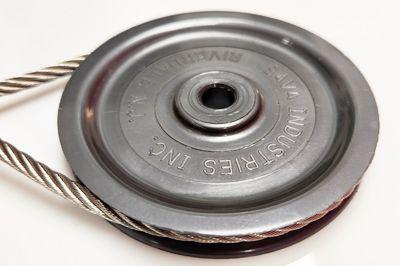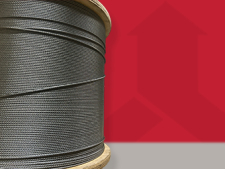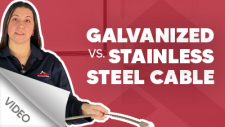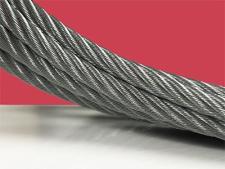What is a Cable Pulley?
A machine by definition, cable pulleys are mechanical devices that reduce the effort applied to move a load, spreading the load over a greater distance or time, by modifying or redirecting an applied force. Pulleys are often used in applications such as control mechanisms, drive systems, power transmissions, and metering equipment, along with countless other applications. Electric vehicle charging stations, for example, have seen a recent increase in pulley usage within their systems, because counterweight is used to retract the electrical dispenser used to deliver electricity to the EV’s charging receptacle.
As a matter of fact, pulleys have been used for approximately 4,000 years now, with the earliest recorded use in Ancient Egypt. Because pulleys are often used to actuate motion or lift heavy loads, they made an ideal simple machine for lifting and transporting massive limestone blocks into position, which ultimately became the Great Pyramids of Giza.
However, because all cables that traverse pulleys experience bending stresses, there are a host of variables that must be considered before mating the cable with a pulley. Among the considerations that may impact the life and strength of the mechanical cable being used are pulley diameter, groove radius, and bearings, if they are improperly designed.
Cable Service Life: Pulley Groove Radius & Pulley Diameter
Sava laboratory testing suggests that poor cable pulley groove compatibility can reduce cable life by as much as 90%.
Given mechanical cable systems requiring pulleys are likely supporting mission critical applications, reducing cable life unexpectedly by such a margin is unacceptable. Subsequently, wire rope must seat properly within the pulley’s groove to ensure fluid movement without experiencing wear-and-tear.
Too large a cable within a pulley groove, for instance, will result in the pulley walls pinching the cable. This undesirable byproduct of groove and cable incompatibility will ultimately result in accelerated wear on the cable. Conversely, too small a cable will result in flattening the cable. This introduces similar, unwanted stresses on the cable, which ultimately files away the monofilaments.
Other preventative considerations include frequently inspecting the pulley groove for worn surfaces. Worn grooves present wear risks to the wire rope. Therefore, it is important to use a groove gauge to monitor the integrity of the pulley groove. What’s more, it is equally critical to replace the pulley as soon as wear becomes noticeable. Furthermore, inaccuracies in the fleet angle, which is the angle between the centerline through the lead pulley and the centerline of the cable leading to a drum, can cause additional wear and reduce service life of the cable as well.


Further Sava testing showed that pulley diameters, less than fifteen wire rope diameters, resulted in low cable life. When a cable bends around a pulley, the strands and wires within the cable need to experience movement relevant to each other, compensating for differences in the underside and topside diameters of the cable. If these components cannot adjust accordingly, the cable’s service life is reduced. Changing direction from one pulley to another also contributes to fatigue.
The relationship between a pulley diameter and a cable is critical to predicting the service life of the cable, and subsequently its fatigue resistance as well. To best maximize the lifespan of a wire rope, following the recommended minimum pulley diameter, as seen in the table below, is advisable.
Browse Our Entire Selection of Mechanical Cables


It is vital to be mindful of cable construction, which helps to inform the flexibility of wire rope. Generally, cables with greater monofilament counts are going to be more flexible. This is because when cables of different constructions are the same diameter, the larger constructions require smaller wires, but more of them, to achieve the desired cable diameter. Hence, a good rule of thumb is that smaller individual wire diameters mean less cross-sectional area, resulting in cables that are less stiff. This all contributes to determining an adequate pulley diameter, so that the cable can make achievable bend radii with relatively no resistance.
When installing mechanical cable into a pulley system, how one installs the cable is also key to achieving an optimum cable lifespan. To do this, simply start the pulley rig and run a cycle at the slowest speed possible. Diligently observe all the working components to ensure that the cable traverses fluidly without experiencing issues. If there are no obstructions present, gradually increase the applied loads and speed to the continuous operating cycles. This installation procedure enables the cable to adjust to the working conditions, which allows for a generous and healthy cable service life.


Mechanical Cable & Wire Rope Strength Efficiency
Just as there cable pulleys impact wire rope and mechanical cable service life, there is an affect on cable strength as well. In part, this is largely due to the bend radii. Tight bending is a major cause of short wire rope life, which includes lost cable strength as well. By contrast, larger pulley diameters, which result in larger bend radii, impose less wear on the cable and results in greater strength efficiency. This can be seen in the table below.
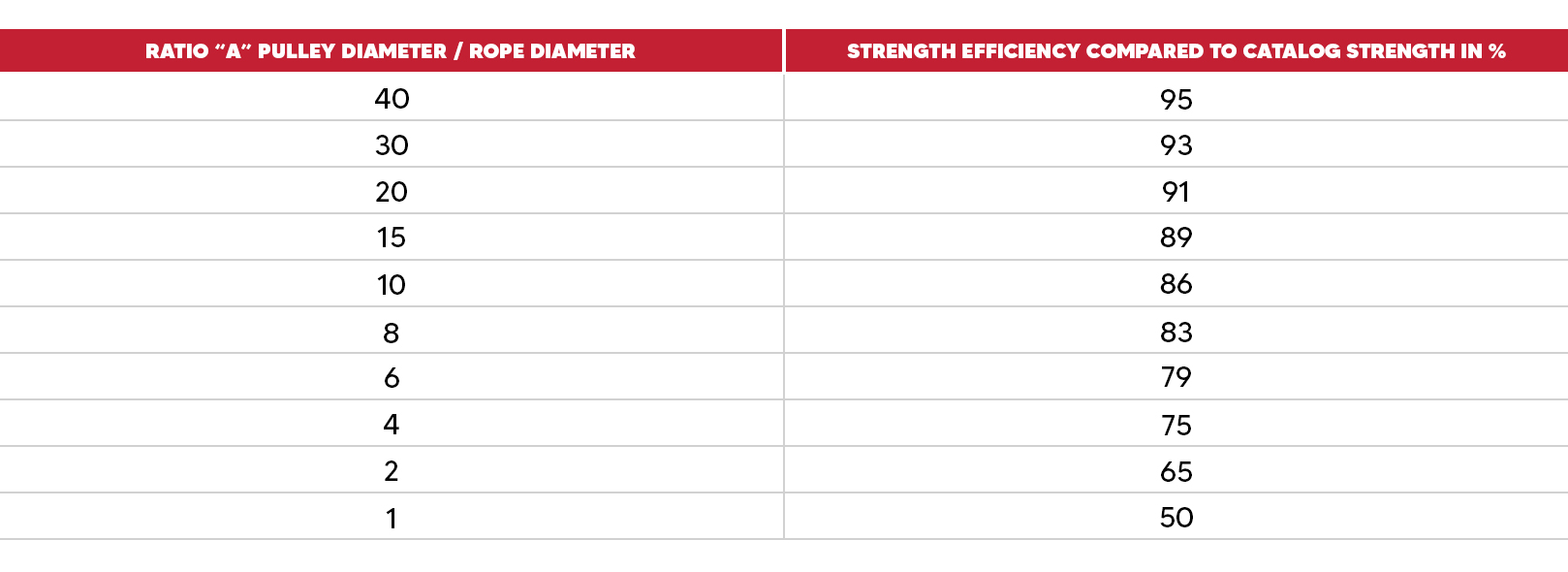

To better express cable strength efficiency, take a .030” diameter cable and a .600” diameter pulley. Using the ratio formula “A” provided in the table above, calculate .600 / .030 = 20 and the corresponding strength efficiency of the cable is 91% as compared to the rated strength of the cable.
As a child, you’ll recall Mom telling you that if you kept making funny faces, they’d never go away. Well, similarly, when a cable is frequently bending and straightening, often repeatedly, the cable experiences fatigue. Over time, cable will experience a change from an elastic to a plastic deformation – which will inhibit the cable’s ability to return to a normal, resting shape. As such, the bend radii have a large influence on cable fatigue. When comparing the pulley diameter and cable diameter using a similar ratio as the one above, the relative fatigue bending life of the cable can be predictably observed, as seen in the table below.


Take, for example, a 2.00” diameter cable and a theoretical 28.00” diameter pulley. Using the ratio formula “B”, in the same format as ratio “A” above, calculate 28.00 / 2.00 = 14 and the corresponding unit of fatigue life is 1.5.
Now take that same diameter cable with a 60.00” diameter pulley, also theoretically speaking.
Calculate using the ratio 60.00 / 2.00 = 30 and the corresponding unit of fatigue life is 10.0. Therefore, the expected fatigue life when using a 60.00” diameter pulley as compared to a 28.00” diameter pulley would be about 6.66667 times greater.


Cable Pulleys Containing Bearings
Bearings are axles used within the pulley to minimize friction as the cable moves around the pulley. To actuate motion with as little friction as possible, bearings consist of two surfaces rolling over each other. In most cases involving pulleys, a number of bearing types can be used, including the following:
PROLLER BEARINGS
Roller bearings are used for applications involving heavy radial loads and high speeds, like conveyors.
FULL COMPLEMENT CYLINDRICAL BEARINGS
Full complement cylindrical bearings are used for applications involving heavy loads and high speeds in continuous operations, such as crane pulleys used in construction.
TAPERED ROLLER BEARINGS
Tapered roller bearings are used for applications involving heavy axial and radial loads and high speeds in continuous operations, most typical including agricultural and mining operations.
OTHER TYPES OF BEARINGS
Other popular bearings for pulleys include needle roller bearings and ball bearings. Another family of bearings, known as bushings, are also common in pulley applications. For instance, bronze bushings can be used for applications involving moderate loads and slow speeds, such as those found in a variety manufacturing equipment.
To achieve the best possible service life of the cable and pulley system, bearings or bushings may require lubrication depending on the material, type of bearing or bushing, and the application requirements.
Pulleys and Wire Rope Pairing
Pulleys are simple machines that spread loads over a distance to reduce effort. They have been around for thousands of years, if not more, performing the very same tasks then that they do now. It is important to understand, that if designed incorrectly, factors such as the groove radius and diameter of the pulley can potentially negatively affect the life and strength of the cable in contact with the pulley. Furthermore, a variety of bearings should be used in pulleys to assist with facilitating rotational motion by providing a significant reduction in frictional forces. If the proper bearing or bushing is not used, pulley systems will be subject to unwanted friction, thus imposing what should have been preventable damage on the wire rope.
Carl Stahl Sava Industries is an industry leader in the design and manufacture of wire rope and pulley systems. Contact our engineering and sales team to make a more informed decision and to begin designing your pulley solutions today!

